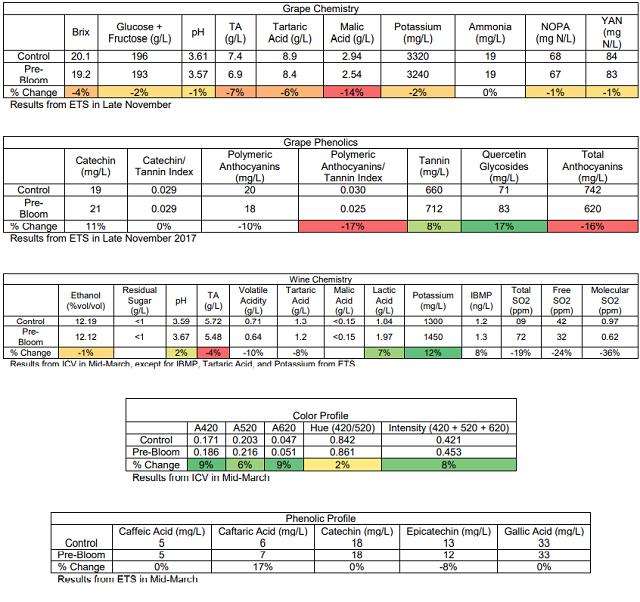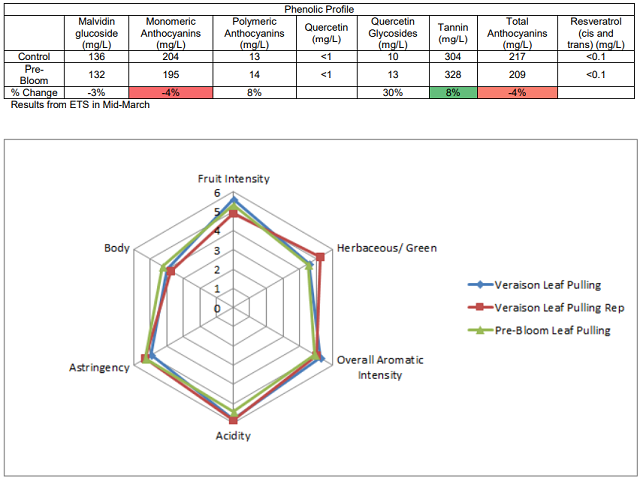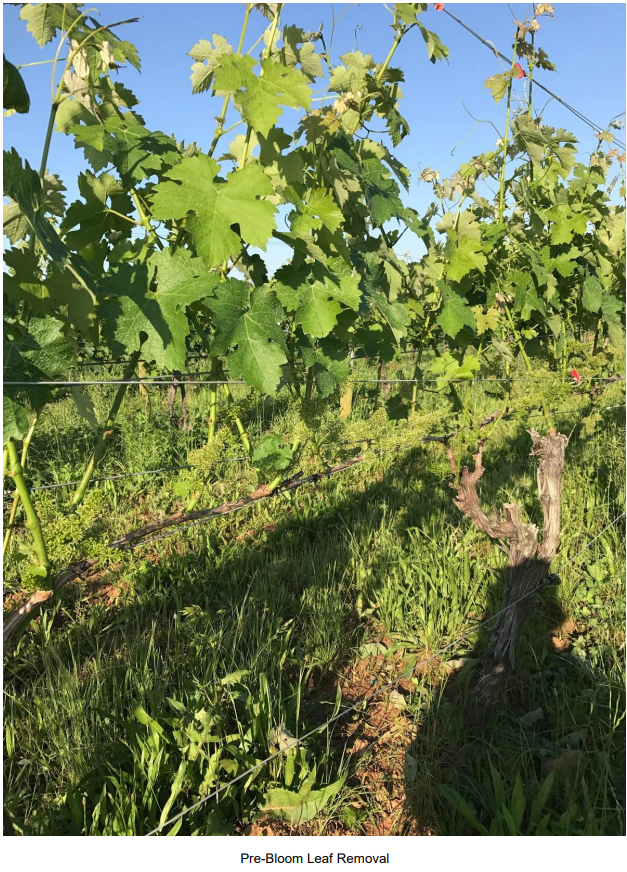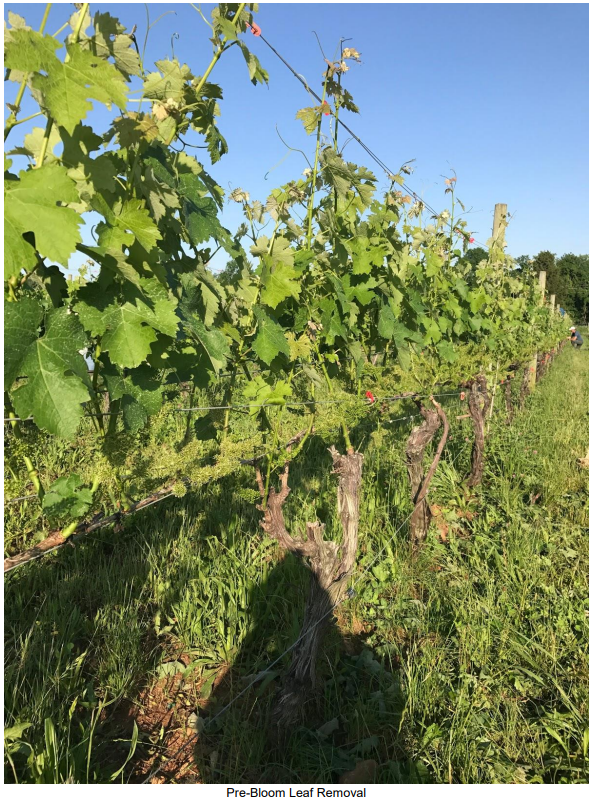The Impact of Bloom Leaf Removal vs Veraison Leaf Removal (2017)
Jordan Harris
Tarara Winery
Summary
This study examines the impact of leaf pulling at either bloom or at veraison. The goal was to have looser clusters and smaller berries from pre-bloom leaf removal. A block of Cabernet Sauvignon (planted 2006) was divided so that every other row was a different treatment. One row had the four-most basal leaves removed at 30% bloom (mid-May), exposing the entire fruiting zone. Continuous passes were made to ensure fruit zone exposure throughout the season. Every other row had leaves removed at the start of veraison, in mid-August. Grapes were harvested and processed at the same times, and all other vineyard and winemaking treatments were identical between treatments. Each wine received a 6-day cold soak, and 25 days of total maceration. Grapes from pre-bloom leaf removal had lower TA, malic acid, and tartaric acid, with a similar pH to the control. Tannin was higher in grapes with pre-bloom leaf removal, but anthocyanins were lower. Pre-bloom wine chemistry was similar except for slightly lower acidity. Color intensity and tannin was also slightly increased in the pre-bloom wine, although these differences were not very pronounced. For the triangle test, of 19 people who answered, 6 people chose the correct wine (32%), suggesting that these wines were not significantly different. In general, of those who answered correctly, no preference trends could be seen between wines. For the descriptive analysis, there were no strong trends for the descriptors used in this study. Most descriptive results were mixed, but Pre-bloom leaf pulling may have had slightly lower Acidity and higher Body. It also may have had slightly less Herbaceous/Green character, but these trends were weak. These results suggest that pre-bloom leaf removal may not always have as large of an impact as is often seen. This practice should be performed more at different sites, on different varieties, and in different vintages (perhaps rainier vintages which may benefit more from this kind of leaf pulling regimen).
Introduction
Leaf pulling in the fruiting zone reduces disease pressure, helps fruit to dry, and can improve chemical composition of the fruit. However, removing too many leaves can result in too high of acid reduction and sunburn. Generally, leaf pulling is performed at or after fruit set, which increases the fruit’s resistance to sunburn (Wolf 2001). However, leaf removal is often performed after berry set. Recently, great interest has arisen in investigating the impact of the timing of leaf removal on fruit yield, micro-climate, and quality.
Because basal leaves at bloom are the primary source of carbohydrates for inflorescences at this stage (Coombe 1962), pre-bloom leaf removal reduces set, potentially reduces berry size, and thus reduces cluster weight (Poni et al. 2006; Tardaguila et al. 2010, Gatti et al. 2012, Palliotti et al. 2012, Risco et al. 2014; Bubola et al. 2017). Early leaf removal results in less compact clusters, which helps to reduce Botrytis incidence as well as reduces crop yield, which may be of benefit from high yield vineyards or with compact clusters (Palliotti et al. 2011; Bubola et al. 2017). It also tends to reduce berry size and enhance many chemical ripeness parameters, such as increasing Brix, tannin, and anthocyanin (Diago et al. 2012, Palliotti et al. 2012, Lee and Skinkis 2013, Cook et al. 2015, Silvestroni et al. 2016; Smith and Centinari 2017; Bubola et al. 2017). Pyrazine is often lowered due to leaf pulling, with early leaf removal often having more impact than later leaf removal (Scheiner et al. 2010). Indeed, early leaf pulling can sometimes impact these ripeness parameters in grapes to a greater extent than cluster thinning, particular in high vigor varieties where cluster thinning does not alter canopy microclimate much (Bubola et al. 2017).
The purpose of this study was to compare leaf pulling pre-bloom to leaf pulling at veraison in Cabernet Sauvignon.
Results and Discussion
Grapes from pre-bloom leaf removal had lower TA, malic acid, and tartaric acid, with a similar pH to the control. Tannin was higher in grapes with pre-bloom leaf removal, but anthocyanins were lower. Pre-bloom wine chemistry was similar except for slightly lower acidity. Color intensity and tannin was also slightly increased in the pre-bloom wine, although these differences were not very pronounced. For the triangle test, of 19 people who answered, 6 people chose the correct wine (32%), suggesting that these wines were not significantly different. In general, of those who answered correctly, no preference trends could be seen between wines. For the descriptive analysis, there were no strong trends for the descriptors used in this study. Most descriptive results were mixed, but Pre-bloom leaf pulling may have had slightly lower Acidity and higher Body. It also may have had slightly less Herbaceous/Green character, but these trends were weak. These results suggest that pre-bloom leaf removal may not always have as large of an impact as is often seen. This practice should be performed more at different sites, on different varieties, and in different vintages (perhaps rainier vintages which may benefit more from this kind of leaf pulling regimen).


Methods
This project was performed on a 3.05 acre block (Penn Silt Loam, 28 rows, very little slope) of Cabernet Sauvignon first planted in 2006 (East-West vines). The four-most basal leaves were removed (working upward) at 30% bloom to every other row (around Mid-May). This left the entire fruiting zone exposed at a very early stage giving excess exposure and lowering the development of the berries. Continuous passes were made throughout the season to ensure the fruiting zone was defoliated throughout the entire season post-bloom. Every other row was a control and had both sides leaf pulled mid-August at the very start of veraison. All other tasks in the block were done identically so the only difference was the leaf removal process. Because it was done every other row opposed to separation by larger blocks, it was geographically almost identical.
Grapes were harvested on October 18, 2017. Both lots were chilled overnight and then destemmed the following day into matching T Bins. No saignee was performed because it was believed that berry size would have a large resulting impact on what would be observed between wines. Both lots received a 6 day cold soak, after which they were inoculated with CSM and Go Ferm. YAN was corrected to 255 using 25g/hL Fermaid and the remainder DAP over a course of four days. Punchdowns started at the start of fermentation, twice daily. After fermentation, punchdowns were once per day until the cap dropped. Wines were pressed on November 13 (25 days total maceration), and only the free run was used for this study. Wine was pressed directly into barrel and inoculated with O-Mega malolactic bacteria. Both lots had completed malolactic conversion and had been sulfured on December 7. Both lots were barreled in third use Jupilles forest barrel from Tonnellerie Magrenen.
These wines were tasted on May 16. For the triangle test, descriptive analysis, and preference analysis, anybody who did not answer the form were removed from consideration for both triangle, degree of difference, and preference. Additionally, anybody who answered the triangle test incorrectly were removed from consideration for degree of difference and preference. Additionally, any data points for preference which did not make sense (such as a person ranking a wine and its replicate at most and least preferred, when they correctly guessed the odd wine) were removed.
In order to balance the data set to perform statistical analysis for descriptive analysis, any judge who had not fully completed the descriptive analysis ratings were removed. In order to then make the number of judges between groups equivalent, one judge from group 3 was eliminated. This resulted in a final data set of 3 groups, each with 6 judges (considered as replications within groups, and groups were considered as assessors). Data was analyzed using Panel Check V1.4.2. Because this is not a truly statistical set-up, any results which are found to be statistically significant (p<0.05) will be denoted as a “strong trend” or a “strong tendency,” as opposed to general trends or tendencies. The statistical significance here will ignore any other significant effects or interactions which may confound the results (such as a statistically significant interaction of Judge x Wine confounding a significant result from Wine alone). The descriptors used in this study were Fruit Intensity, Herbaceous/Green, Overall Aromatic Intensity, Acidity, Astringency, and Body.


References
Bubola, M., Paolo Sivilotti, P., Janjanin, D., and Poni, S. 2017. Early leaf removal has larger effect than cluster thinning on cv. Teran grape phenolic composition. Am. J. Enol. Vitic. In Press.
Cook, M.G., Zhang, Y., Nelson, C.J., Gambetta, G., Kennedy, J.A., and Kurtural, S.K. 2015. Anthocyanin composition of Merlot is ameliorated by light microclimate and irrigation in Central California. Am J Enol Vitic 66: 266-278.
Coombe, B.G. 1962. The effect of removing leaves, flowers and shoot tips on fruit-set in Vitis vinifera L. J. Hortic. Sci. 37:1-15.
Coombe, B.G. 1962. The effect of removing leaves, flowers and shoot tips on fruit-set in Vitis vinifera L. J Hortic Sci 37:1-15. 423
Diago, M.P., Ayestarán, B., Guadalupe, Z., Poni, S., and Tardáguila, J. 2012. Impact of prebloom and fruit set basal leaf removal on the flavonol and anthocyanin composition of Tempranillo grapes. Am J Enol Vitic 63:367-376.
Gatti, M., Bernizzoni, F., Civardi, S., and Poni, S. 2012. Effects of cluster thinning and preflowering leaf removal on growth and grape composition in cv. Sangiovese. Am J Enol Vitic 63:325-332.
Lee, J. and Skinkis, P.A. 2013. Oregon 'Pinot noir' grape anthocyanin enhancement by early leaf removal. Food Chem 139:893-901.
Palliotti, A., Gardi, T., Berrios, J.G., Civardi, S., and Poni, S. 2012. Early source limitation as a tool for yield control and wine quality improvement in a high-yielding red Vitis vinifera L. cultivar. Sci Hortic 145:10-16.
Palliotti, A., Gatti, M., and Poni, S. 2011. Early leaf removal to improve vineyard efficiency: gas exchange, source-to-sink balance, and reserve storage responses. Am J Enol Vitic 62:219-228.
Poni, S., Casalini, L., Bernizzoni, F., Civardi, S., and Intrieri, C. 2006. Effects of early defoliation on shoot photosynthesis, yield components, and grape composition. Am J. Enol. Vitic. 57: 397-407.
Risco, D., Pèrez, D., Yeves, A., Castel, J.R., and Intrigliolo, D.S. 2014. Early defoliation in a temperate warm and semi-arid Tempranillo vineyard: vine performance and grape composition. Aust J Grape Wine Res 20:111-122.
Scheiner, J.J., Sacks, G.L., Pan, B., Ennahli, S., Tarlton, L., Wise, A., Lerch, S.D., and Vanden Heuvel, J.E. 2010. Impact of severity and timing of basal leaf removal on 3-isobutyl-2-methoxypyrazine concentrations in red winegrapes. Am. J. Enol. Vitic. 61: 358-364.
Silvestroni, O., Lanari, V., Lattanzi, T., Alberto, A., and Sabbatini, P. 2016. Impact of crop control strategies on performance of high-yielding Sangiovese grapevines. Am J Enol Vitic 67:407-418.
Smith, M. and Centinari, M. 2017. Early season grapevine canopy management, Part II: Early leaf removal (ELR). Wine & Grapes U. https://psuwineandgrapes.wordpress.com/2017/06/02/earlyseason-grapevine-canopy-management-part-ii-early-leaf-removal-elr/
Sternad Lemut, M., Sivilotti, P., Butinar, L., Laganis, J., and Vrhovsek, U. 2015. Pre-flowering leaf removal alters grape microbial population and offers good potential for a more sustainable and cost-effective management of a Pinot Noir vineyard. Aust J Grape Wine Res 21:439-450.
Tardáguila, J., de Toda, F.M., Poni, S. and Diago, M.P. 2010. Impact of early leaf removal on yield and fruit and wine composition of Vitis vinifera L. Graciano and Carignan. Am J Enol Vitic 61:372-381.
Wolf, T. 2001. Canopy management tips. Viticulture Notes 16(3). Vineyard and Winery Information Series. http://www.sites.ext.vt.edu/newsletter-archive/viticulture/01mayjune/01mayjune.html
